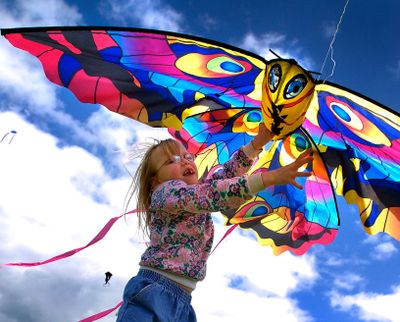Weathercatch: Why now is the time to go fly a kite

March and April are the windiest months of the year in the Inland Northwest. In the Spokane area, the average hourly wind speed is close to 9 mph during both months. By comparison, average wind speeds during August and September run about 5.5 mph.
The best kite-flying weather consists of breezes ranging between 6-22 mph, according to the International Kite-flying Association. No wonder we often see colorful kites zigzagging against the sky this time of year and less so during summer.
We typically see both stronger winds and more windy days in March and April. Why the uptick? First of all, since winter hasn’t completely cleared out, cold air masses linger. At the same time, warm air masses are advancing from the south. Also, intensifying sunshine is heating air close to the ground. The clash between the remnants of cold air and the escalating warm air produces air pressure gradients that produce wind.
Of course, those clashes can help generate thunderstorms that vault wind speeds as well.
So when the forecast frequently calls for breezy, gusty, windy, or blustery conditions, rest assured that it’s normal this time of year. While increased winds can make spring feel like an atmospheric brawl, keep in mind that many locations in the United States are far windier. There’s a reason Spokane is known as the Lilac City and not the Windy City. That nickname famously belongs to Chicago, which, with an average wind speed of 10.3 mph, doesn’t even crack the top 10 windiest cities.
But Dodge City, Kansas, does. In fact, with an average wind speed of 13.3 mph, it places among the top five windiest cities. On St. Patrick’s Day last week, its local office of the National Weather Service reported sustained winds of 37 mph with gusts reaching 52 mph. In the Spokane area, we’d consider that pretty darned windy. In Dodge City, not so much.
Rochester, Minnesota; Cheyenne, Wyoming; and Fargo, North Dakota, also rank high on the windiest cities chart. Note that all of these places are located in the Plains and upper Midwest.
Unlike the hills, mountains and forests of the Pacific Northwest, this large, mostly flat expanse of fertile land offers few obstacles to impede winds. It’s also atmospherically dynamic, resulting in clashes of air masses far more powerful than what we experience in the Inland Northwest.
The next time you peddle your bike into a strong headwind or clutch your hat while crossing the street, keep in mind that when it comes to springtime wind, we’ve got it relatively easy. Much of the time, it’s enough to lift kites and spirits alike.
Nic Loyd is a meteorologist in Washington state. Linda Weiford is a writer in Moscow, Idaho, who’s also a weather geek. Contact: ldweiford@gmail.com.